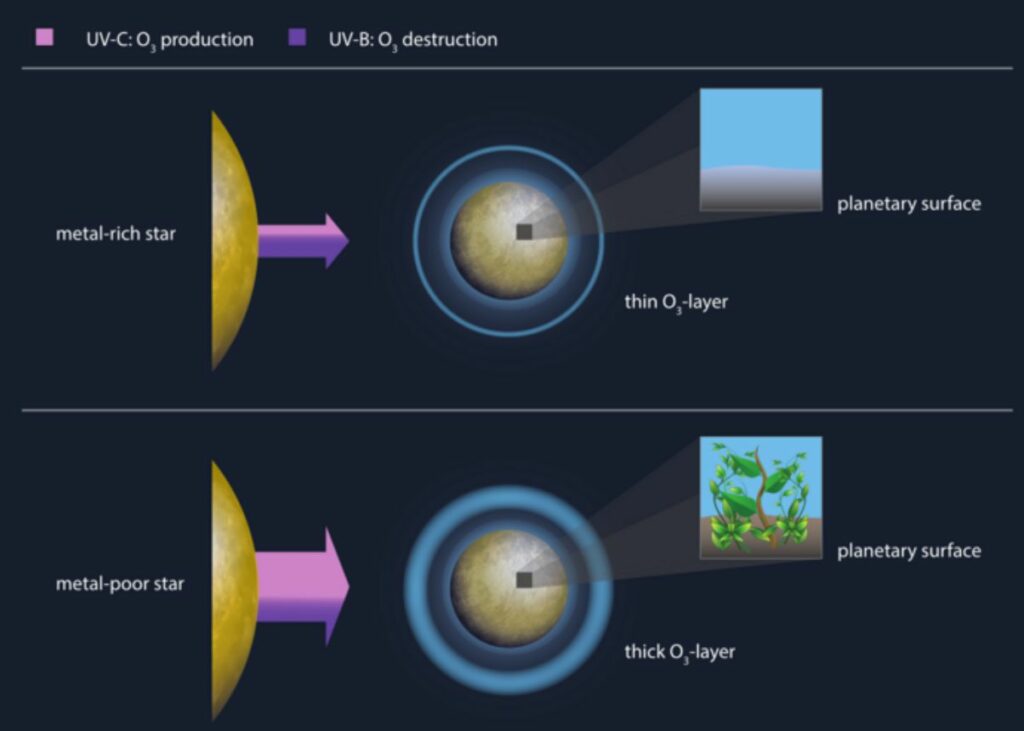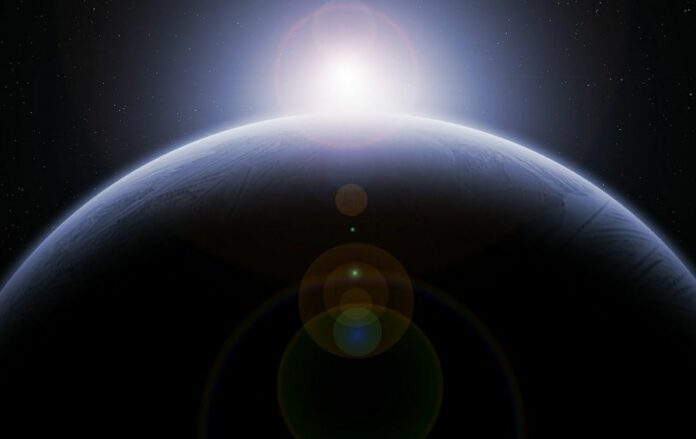Are metal-poor stars better for supporting complex life? A new study reveals how a star’s chemical composition affects the emergence of complex life in its neighborhood and how metal-poor stars may provide more favorable conditions for habitable exoplanets.
Scientists have discovered that stars with lower metal content are more conducive to supporting complex life than metal-rich stars. The chemical composition of a star plays a significant role in the ultraviolet radiation it emits into space, and thus affects the conditions for life in its surroundings.
Researchers from the Max Planck Institutes for Solar System Research and for Chemistry, as well as the University of Göttingen, found that a star’s metallicity is linked to the ability of its planets to develop a protective ozone layer, which shields life from harmful UV radiation.
The findings provide important clues for space telescope missions searching for habitable star systems, and raise the surprising conclusion that as the universe ages, it may become increasingly hostile to the emergence of complex life on new planets.
Scientists searching for potentially habitable exoplanets have recently shifted their focus to the gas envelopes surrounding these distant worlds. By analyzing observational data, researchers hope to detect signs of an atmosphere and gases like oxygen and methane, which are typically associated with life. In the coming years, the James Webb Telescope from NASA will push the boundaries of this research, allowing scientists to characterize the atmospheres of large gas giants and even analyze the faint spectrographic signals from rocky planet atmospheres for the first time.
The recently published study in Nature Communications utilizes numerical simulations to investigate the ozone content of exoplanet atmospheres. Ozone, consisting of three oxygen atoms, can shield the planet’s surface and its inhabitants from harmful ultraviolet radiation, similar to Earth. Therefore, having a protective layer of ozone is crucial for the emergence of complex life.
First author Anna Shapiro says that they “wanted to understand what properties a star must have in order for its planets to form a protective ozone layer.”
Scientific ideas are often sparked by previous findings, and this was no exception. In this case, a group of researchers led by the Max Planck Institute for Solar System Research conducted a study three years ago, in which they compared the Sun’s brightness variations to those of hundreds of stars with similar characteristics. The findings were surprising: many of these stars exhibited significantly greater fluctuations in visible light intensity than the Sun.

“We saw huge peaks in intensity,” says Alexander Shapiro, who was involved in both the analyses from three years ago and the current study. “It is therefore quite possible, that the Sun, too, is capable of such spikes in intensity. In that case, also the intensity of the ultraviolet light would increase dramatically”, he adds.
Alexander Shapiro, who participated in both the previous and current analyses, stated that they “saw huge peaks in intensity.”
“So naturally we wondered, what this would mean for life on Earth and what the situation is like in other star systems”, adds Sami Solanki, who was also involved in both works as co-author.
Dual function of UV radiation
Temperatures on the surface of almost half of all stars known to host exoplanets vary from 5,000 to 6,000 degrees Celsius. As a result, the researchers focused their calculations on this subset. The Sun is one among them, with a surface temperature of around 5500 degrees Celsius.
Anna Shapiro, whose previous research focused on the effects of solar radiation on Earth’s atmosphere, explains that ultraviolet radiation from the Sun has a dual role in Earth’s atmospheric chemistry.
Ozone can be both created and destroyed in reactions with individual oxygen atoms and molecules. However, long-wave UV-B radiation is responsible for destroying ozone, while short-wave UV-C radiation helps to create a protective ozone layer in the middle atmosphere.
“It was therefore reasonable to assume that ultraviolet light may have a similarly complex influence on exoplanet atmospheres as well,” according to the author.
The exact wavelengths are very important.
The study’s researchers conducted precise calculations of the wavelengths of ultraviolet light that stars emit. This is the first time that the researchers also took into account the impact of metallicity, which refers to the proportion of hydrogen to heavier elements (sometimes referred to as “metals” by astrophysicists) in the star’s building materials. For instance, in the case of the Sun, there are over 31,000 hydrogen atoms for each iron atom. The team also considered stars with higher and lower iron content.
Simulated UV radiation-gas interactions
The researchers took a further step and examined the impact of the calculated UV radiation on the atmospheres of planets orbiting at a distance conducive to life. These planets are situated at a moderate temperature range, neither too hot nor too cold, allowing for liquid water to exist on their surfaces. Using computer simulations, the team accurately simulated the chemical processes triggered by the star’s UV light in the planet’s atmosphere.
The researchers utilized a sophisticated chemistry-climate model to calculate the composition of planetary atmospheres. The model simulated the intricate processes that regulate the behavior of oxygen, ozone, and other gases in response to ultraviolet radiation from stars at an extremely high level of detail. This enabled the scientists to investigate a broad range of conditions on exoplanets and compare them with the history of the Earth’s atmosphere over the last 500 million years. During this time, the atmosphere achieved a high level of oxygen content and an ozone layer that allowed life to evolve on land.
According to Jos Lelieveld, the Managing Director of the Max Planck Institute for Chemistry, who participated in the study, it is plausible that the history of the Earth and its atmosphere could provide valuable insights into the evolution of life that could also be relevant to exoplanets.
Candidates with potential
They were taken aback by the findings of the simulations, as they revealed that metal-poor stars actually emit more UV radiation than their metal-rich counterparts. However, the critical factor in the formation of a dense ozone layer is the ratio between UV-C radiation, which generates ozone, and UV-B radiation, which destroys it. In the case of metal-poor stars, the predominance of UV-C radiation allows for the formation of a protective ozone layer. Conversely, metal-rich stars with their higher levels of UV-B radiation have much sparser ozone protection.
“Contrary to expectations, metal-poor stars should thus provide more favourable conditions for the emergence of life,” concludes Anna Shapiro.
The discovery of the relationship between a star’s metallicity and the potential for habitable planets could prove to be valuable information for upcoming space missions, such as the European Space Agency’s Plato mission. Set to launch in 2026, the mission will use its 26 telescopes to search for Earth-like planets orbiting Sun-like stars at life-friendly distances. The Max Planck Institute for Solar System Research is currently setting up the mission’s data center, making it a hub for the analysis of the mission’s findings.
This new “study gives us valuable clues as to which stars Plato should pay special attention to,” remarks co-author Laurent Gizon.
The study’s findings reveal an almost ironic outcome: as the universe continues to age, it may become more inimical to supporting life. This is due to heavy elements, including metals, being formed within stars towards the end of their multi-billion-year existence and subsequently released into space through processes like supernova explosions and stellar wind. These elements serve as the building blocks for the creation of subsequent stars, making them increasingly metal-rich as time goes on.
“Each newly forming star therefore has more metal-rich building material available than its predecessors. Stars in the universe are becoming more metal-rich with each generation,” adds Anna Shapiro.
As per the recent study, the likelihood of star systems producing life decreases with the aging of the universe. Nonetheless, the search for life is not without hope, as many exoplanet-hosting stars are similar in age to our Sun, which supports complex and fascinating life on at least one of its planets.
Source: 10.1038/s41467-023-37195-4
